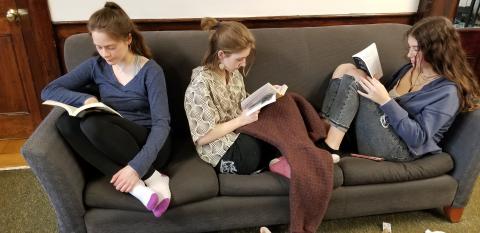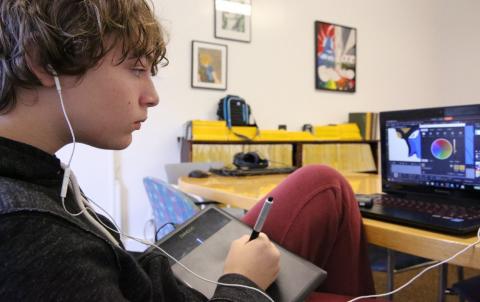The vast enterprise that has been created for the purpose of educating all of the nation’s youth is founded on a number of hypotheses. Together, they give the appearance of a powerful set of assumptions that cannot be reasonably challenged. They are the product of the best minds applying their wisdom to the sacred task of preparing our children to be effective adults when they grow up.
It turns out that when you examine these hypotheses, they do not hold up to scrutiny. The grand edifice of education is built on a foundation of quicksand.
Here is a list of the false beliefs at the core of prevailing educational practices:
1. “If you teach, they will learn”
Let’s accept the fact that everyone, of every age, is learning something all the time; you can’t be alive and sensate without absorbing information and acquiring knowledge. The question is this: if we want a particular person to learn a particular bunch of stuff, how can we make that happen? The prevailing solution: teach them! Get someone designated as a “teacher” who will know the stuff under consideration, and have that teacher input the requisite information to the person who is expected to learn it.
The fallacy: Teaching does not necessarily, or even usually, lead to learning. In order to learn something, one has to be willing and eager to absorb it, to make it part of one’s store of knowledge. You have to want to own it, and to be willing to go to whatever lengths are necessary in order to understand it. Having someone talk to us about something that doesn’t interest us, or that we have not sought to hear, doesn’t imply that we’ll remember what that person said, or find it useful later. As Russell Ackoff was wont to say: in a standard educational setting, the only person who learns is the teacher, who is always motivated to understand the material s/he is called on to explain.
2. “Trained teachers are the only ones qualified to impart knowledge in the subjects they teach”
Teacher training has it all backwards. Its main focus is on trying to show prospective teachers how to get students to learn stuff they don’t want to learn—an activity called “pedagogy”. The second part of teacher training is the application of pedagogy to a particular subject that the prospective teacher will end up teaching. There is no requirement that the trainee be an expert in the subject being taught—no advanced degree, or even a college major, in the subject is a prerequisite.
The fallacy: As we saw in #1, the goal of pedagogy is all but impossible to achieve, so that part of teacher training is quite useless. In addition, since trained teachers are rarely actually qualified to teach their subject in depth, it is hard to imagine how they can impart knowledge they don’t possess, even if the student is eager to learn!
The most qualified people to teach material are those who have studied it most intensively, such as experienced practitioners of the field. Oddly, in most schools, such people are not recruited or hired, giving rise to the rather uncomplimentary saying, “Those who can—do; those who can’t—teach!”
3. “Human knowledge can be divided into discreet subject areas”
While we’re on the topic of “subjects”, it is worth noting that the present general division of human knowledge into “subjects”—math, logic, physics, biology, rhetoric, etc.—was first made by students at Aristotle’s “Walk-around School” (a.k.a. “The Peripatetic School”) some 2400 years ago. Some of them took notes and, to organize those notes and the ideas they had absorbed from their conversations, they labeled them with names that later became memorialized as “subject areas”. Over time, more areas came to be defined, and “knowledge” came to be further fragmented, until academicians, feeling constricted by so many labels, introduced the concept of “interdisciplinary studies”—something they felt was a great innovation.
The fallacy: Just ask yourself a simple question: when you think about a problem—any problem—do you first say to yourself, “What subject area does this problem fall into?”, or do you search for anything you know that can help you solve the problem? In real life, “subjects” are a useless detour on the path to wisdom.
4. “There are experts who can identify what everyone must know to be successful”
Schools were established as places where children could prepare for life as adults. In the 19th century, those responsible for establishing compulsory education for all children saw it as their task to define all the factors that go into making a successful adult, and then try to arrange for every child to master those factors. Those subjects were combined into a comprehensive curriculum for all schools, an act that educators believed would enable children to be thoroughly prepared to face the world. During the past half century, educators have primarily turned to academicians to serve as the experts in defining what the curriculum should contain.
The fallacy: Over 2500 years ago, the Greek philosopher Heraclitus, a careful and thoughtful observer, proclaimed that the key feature of the world around him could be summarized in a simple phrase: “All Is Change”. It is a refrain heard more frequently than any other nowadays. Change in every walk of life is accelerating at a dizzying pace, and no one can predict what will be important and relevant when the child of today becomes the adult of tomorrow. The only sure thing—and students all know this—is that the current state of knowledge in any domain will not remain unchanged in the future.
5. “Children cannot be trusted to discover, and find ways to master, what they need to know to be successful adults”
That statement is considered almost too obvious to discuss. It is the backdrop for the whole panoply of formal education today (see especially #2 and #4 above). No one offers this proposal concerning adults—or at least, in a free society such as ours, no one has suggested forcing adults to be subjected to the teaching of formal curricula all their lives. The right to life, liberty, and the pursuit of happiness is one granted to every adult, and clearly prohibits impositions on adults that would threaten their lives, and their freedom of action to pursue the goals that give meaning to their daily existence. But children are seen as different in essence, so much so that even in a free society like ours they can be treated as persons with no inherent rights at all—least of all, the right to control their own education.
The fallacy: No one has ever presented a theoretical justification for this differentiation between adults and children. One just hears declarations that are presented as facts—statements like “children don’t have judgment”, “children are lazy”, “children will always take the path of least resistance”, “children waste time”, and on and on. The fact that the human species could not have survived, as it did, for over 200,000 years without schools should be sufficient evidence that children have inborn drives and abilities to mature into successfully functioning adults without the intervention of a formal educational structure dedicated to directing their lives. In fact, no species can survive if its young are not born with the ability to grow up into functional adults.
6. “Schools are needed to separate true information from the mass of false information that can mislead children”
Schools are considered the primary guides to the separation of “objective facts” from “falsehoods”. To this end, the contents of school curricula are carefully prepared by the same cohort of “experts” who created the curricula, to make sure that those materials contain valid information.
The fallacy: The information imparted by teachers and class materials in schools is not necessarily more “reliable” in its truth-value than other information available elsewhere. The inherent biases that define the world-views of the people compiling the curricula permeate it. Representing that information as more worthy of consideration than information emanating from other sources—and certainly of greater value than that garnered by the efforts of the students alone—can only lead to one outcome: the undermining of students’ confidence in their own judgment, and a command always to yield to the judgment of others considered their superiors.
7. “Science labs show students how scientific experiments are done”
Apropos of “truth”, a particular focus of current teaching in schools is science, which is represented as an unimpeachable source of valid information about any domain that science has coopted into its sphere of relevance. Thus, schools at all levels are equipped with “science labs” where students, under the guidance of teachers, are allegedly learning the meticulous methods scientists use to glean truths about their world. By being exposed to these laboratories, children are supposed to be learning the most valuable techniques for separating truth from falsehood. Students are taught to do experiments, which they are told is the essence of the “scientific method”—to wit, the pro-active posing of questions to the objects of study, and then letting those objects reveal their answers directly to you.
The fallacy: In fact, school science labs teach the exact opposite of what is purported. I never really thought about this until I myself was in the position of being a science teacher in an introductory college physics course. In the first laboratory session, I explained to the class how they were going to ask Nature how large the acceleration of gravity is by doing an experiment that would reveal the answer. What was involved was rolling a ball down an inclined plane of measured length and timing how long it took the ball to reach the bottom. It was as simple and clear an experiment as could be designed.
They all went about their measurements carefully, and came to show me their answers. Alas, not only did they see that the various answers found by different students weren’t all the same, but I also had to tell them that all their answers were wrong. The right answer was so-and-so, measured by scientists working in a government laboratory. The lesson: when going to science lab, be aware that there is a right answer known in advance by your teacher, and you are going to be judged by how close you got to the right answer. So much for asking Nature a question and receiving the answer directly.
Not only is science lab a fraud, bearing no relation to what professionals do, but students learn that science is an exercise in getting the answer that the authorities in the field have approved.
8. “Success is doing things right; failure is doing things wrong”
It seems so reasonable to say, “If you want to be a success, you have to do things right, otherwise you will be a failure.” Isn’t it obvious that getting things wrong is a bad way to go through life? Would you bring your car to a mechanic who generally makes mistakes when trying to fix problems? Would you go to a lawyer who is known to file briefs that miss the legal points that will win a case?
So schools hammer into students the notion that being a good student means getting everything right—on tests, in writing exercises, in research projects, on the playing field. The GPA (“Grade Point Average”) reigns supreme; the more “rights” you have accumulated, the better your prospects are seen to be for your future.
The fallacy: Oddly, the very same people who praise a student for getting things right, and penalize a student for getting things wrong, trumpet the maxim, “Learn from your mistakes!” Actually, we never really learn much from doing things right, because if we do something right, we already knew what to do, so doing it doesn’t signify progress; at best it signifies that we haven’t forgotten what we already knew. We move forward in life by making mistakes and learning from them. Mistakes are the quintessential opportunities for gaining knowledge, insight, and wisdom. They should never be an object of scorn or disapproval; they should be seized upon as the stepping stones towards success. Worshiping at the altar of the GPA is following a false god, if ever there was one.
9. “The way for children to learn how to be citizens of a free society is to teach them about it”
With the passage of time, school-age children will end up being adults in American society. Educators figured that it would be good if they gained some understanding of the socio-economic structure of this country, and of the value system that defines American culture. It should come as no surprise that the way this was addressed was by adding classes to the school curriculum, where students would be taught the ins and outs of the American system. A glance at #1 above will make it clear how successful that proposal was destined to be.
The fallacy: The real issue is a deeper one. As anthropologists discovered early in the 20th century, one cannot hope to understand a culture without being immersed in it, and engaging in its activities and practices. That, of course, is the way children born into a culture absorb its language, its customs, and its values: by being immersed in it and becoming an integral part of its daily life. How odd, then, that educators have decided to immerse children in a totally autocratic school system for at least 12 years (more if they go to college), where they have no rights, no system of fair justice, and no say in the rules that govern them—the polar opposite of the essential features of American culture. The result is young adults who have not experienced life in a free environment, and who cannot be expected to know how to navigate its complex and challenging byways.
10. “There exist objective ways to evaluate any aspect of people’s intelligence, knowledge, and prospects for their future success”
During the last half of the 20th century, educators became obsessed with concepts such as “assessment”, “accountability”, and “standardized testing”. All of these amounted to the same thing: accepting the notion that intelligence, knowledge, and prospects for future success are quantifiable entities to which specific numerical values can be attached. To achieve such a challenging set of goals, a host of definitions had to be created, methods to quantify them invented, and standards established.
For example, one had to decide how to define “intelligence” in a way that suggests quantification. The dictionary defines the word as follows: “The ability to acquire, understand, and use knowledge.” Educators, with the help of psychologists, managed to concoct a measure for that ability, and numbers such as “IQ” have come to be used widely. Similarly, “experts” had to come up with specific items that they agreed would be indicators of knowing a certain subject. So, for example, if you knew what the Triple Entente was, it was a sign you knew European history; if you didn’t know what it was, well . . .
The fallacy: We didn’t need Professor Howard Gardner of Harvard to reveal that people have “multiple intelligences”1; it has always been obvious that different people are good at different things, and that the full range of humanity has managed to display high levels of creative thought and understanding in areas of boundless variety. To attach a measurable number to something that has no limit is plain nonsense. As to “knowledge”, who can be so bold as to outline the limits of human knowledge, especially in an era that has seen an “information explosion” reveal the endless inventiveness of the human mind. So what can be measured here? Whether a person has memorized certain pieces of data? Why should anyone care? What use could that be?
The entire panoply of tests, assessments, evaluations, whatever-you-call-them, actually serve only one purpose: to provide a basis for doling out the constantly growing quantity of money being thrown at education to reward good scores, in the vain hope that money will improve a stagnant system.
Ten Wrongs Make—One Grand Mess
When any social institution turns out to be based on false premises, it is only a matter of time before it collapses of its own internal contradictions. No one can predict when this will happen to our educational system. You will look in vain for a single “expert” who predicted the collapse of the Soviet Union in 1990 even six months before it happened, or any of a host of other sudden historical transformations on the eve of their occurrence. The message to schools could well be the one given two thousand years ago to the Persian king Belshazzar, and interpreted by the prophet Daniel: “Then the hand was sent from Him and this inscription was written out. Now this is the inscription that was written out: ‘MENE, MENE, TEKEL, UPHARSIN.’ This is the interpretation of the message: ‘MENE’—God has numbered your kingdom and put an end to it.”2
ENDNOTES
1.Although, true to academic form, Professor Gardner was quick to enumerate and provide specific definitions of the intelligences he had introduced.
2.Daniel, Chapter 5, verses 24-26.
Copyright © Sudbury Valley School Press ®



